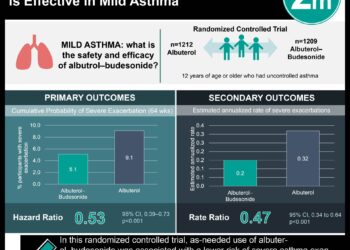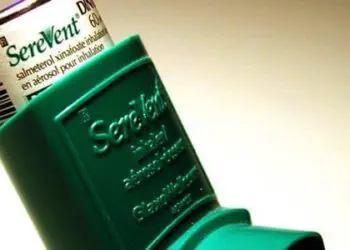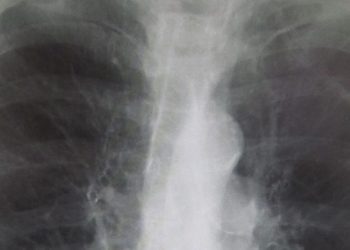Continuous albuterol thought to be safe in floor setting
1. Children treated with continuous aerosolized albuterol (CAA) in a non-intensive care unit (ICU) setting had low rates of adverse events and clinical deterioration.
2. Concomitant pneumonia, history of previous hospitalizations, and severe symptoms at presentation were more likely to predict clinical deterioration in patients requiring CAA.
Evidence Rating Level: 2 (Good)
Study Rundown: Status asthmaticus is the leading cause for hospitalization in the pediatric population. Treatment of status asthmaticus includes CAA as it has better efficacy than intermittent albuterol treatments for controlling severe symptoms. Patients on CAA require close monitoring for side effects such as hypokalemia and cardiac rhythm disturbances. While CAA has been previously shown to be safe in the Emergency Department and ICU setting, there is little literature to support its safety profile in a non-ICU setting. This study pooled data from patients who were treated with CAA in the inpatient setting to investigate clinical worsening, requirement for prolonged treatment, and adverse effects. Researchers found low rates of adverse events for patients treated outside the ICU. Though limited by its inability to directly compare patients in non-ICU versus ICU settings, this study suggests that with appropriate clinical practice guidelines and resources, administration of CAA outside the ICU setting for status asthmaticus can be both safe and cost-saving.
Click to read the study, published today in Pediatrics
Relevant Reading: Continuous versus intermittent beta-agonists for acute asthma (Cochrane Review)
Study Author, Dr. Chén C. Kenyon, MD, MSHP, talks to 2 Minute Medicine: Division of General Pediatrics and Center for Pediatric Clinical Effectiveness, The Children’s Hospital of Philadelphia and Perelman School of Medicine, University of Pennsylvania, Philadelphia, Pennsylvania.
“This study demonstrates that with the appropriate clinical support infrastructure and resources, continuous albuterol can be delivered to children in the non-ICU setting with similar rates of adverse effects compared to intermittent albuterol. We also identified a number of factors associated with clinical deterioration – including concomitant pneumonia and ED therapy with intravenous magnesium or subcutaneous terbutaline – that may help clinicians assess which patients receiving continuous albuterol may need more intensive airway and clinical support. These data may help other institutions assess what type of resources are necessary to safely provide continuous albuterol on the floor and, if they do not have a pediatric ICU, identify patients that may be best cared for at an institution with pediatric intensive care. Future work should identify which patients are likely to benefit most from continuous albuterol and what duration of therapy is appropriate when patients are not responding to this therapy.”
In-Depth [retrospective cohort]: This retrospective cohort analysis examined 3003 children ages 2 to 18 with status asthmaticus treated in an inpatient floor setting at a single freestanding children’s hospital. All providers followed a clinical practice guideline algorithm for assessment of asthma. Of included patients, 1298 (43%) received CAA, while the rest required intermittent albuterol. Median duration of CAA treatment was 14.4 hours (interquartile range: 7.7 – 24.6). Five percent of CAA patients clinically deteriorated, requiring either enhanced respiratory support (high flow nasal cannula, 3.7%), transfer to the ICU (4.1%), or both (2.5%). Comorbid pneumonia (OR 3.9, P < 0.001), history of previous hospitalizations (OR 1.5, P = 0.03), or symptoms severe enough to require adjuvant therapies such as magnesium (OR = 1.8, P = 0.05) or terbutaline (OR = 3.2, P = 0.003) were more likely to predict need for clinical deterioration in patients requiring CAA versus intermittent albuterol. No children required intubation. Rates of hypokalemia and cardiac rhythm disturbances were thought to be similar between CAA and intermittent albuterol groups, though the study was not adequately powered to assess these differences.
More from this author: Study suggests twice as many antimicrobials prescribed than needed, MMR vaccination intentions higher with direct benefit education, Severity of complications in pediatric influenza-like illness identified, High prevalence of pediatric dosing errors suggests unit standardization, Sexting linked to sexual activity in middle school students
Image: PD
©2012-2014 2minutemedicine.com. All rights reserved. No works may be reproduced without expressed written consent from 2minutemedicine.com. Disclaimer: We present factual information directly from peer reviewed medical journals. No post should be construed as medical advice and is not intended as such by the authors, editors, staff or by 2minutemedicine.com. PLEASE SEE A HEALTHCARE PROVIDER IN YOUR AREA IF YOU SEEK MEDICAL ADVICE OF ANY SORT.







